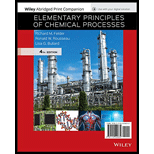
Concept explainers
A gas stream containing 40.0 mole% hydrogen, 35.0% carbon monoxide, 20.0% carbon dioxide, and 5.0% methane is cooled from 1000°C to 10°C at a constant absolute pressure of 35 atm. Gas enters the cooler at 120 m3/min, and upon leaving the cooler, is fed to an absorber where it is contacted with refrigerated liquid methanol that enters the absorber at a molar ?ow rate 1.2 times that of the inlet gas and at — 155°C. Essentially all of the CO2is absorbed, as is 98% of the methane and an inconsequential amount of the other components of the feed gas. The gas leaving the absorber is saturated with methanol at −12°C and is fed to a reactor for further processing.
(a) Calculate the volumetric ?ow rate of methanol entering the absorber (m3/min) and the molar ?ow rate of methanol in the gas leaving the absorber. D0 not assume ideal-gas behavior when doing PVT calculations.
(b) List and explain at least three hazards associated with the system described.
(c) One of the possible uses of the product gas is as a feed to a reactor in which the water-gas shift reaction takes place:
Learn your wayIncludes step-by-step video

Chapter 6 Solutions
ELEM.PRIN.OF CHEMICAL...ABRIDGED (LL)
Additional Engineering Textbook Solutions
Starting Out with Python (4th Edition)
Database Concepts (8th Edition)
Modern Database Management
Java: An Introduction to Problem Solving and Programming (8th Edition)
BASIC BIOMECHANICS
Elementary Surveying: An Introduction To Geomatics (15th Edition)
- Nonearrow_forwardTransmitance 3. Which one of the following compounds corresponds to this IR spectrum? Point out the absorption band(s) that helped you decide. OH H3C OH H₂C CH3 H3C CH3 H3C INFRARED SPECTRUM 0.8- 0.6 0.4- 0.2 3000 2000 1000 Wavenumber (cm-1) 4. Consider this compound: H3C On the structure above, label the different types of H's as A, B, C, etc. In table form, list the labeled signals, and for each one state the number of hydrogens, their shifts, and the splitting you would observe for these hydrogens in the ¹H NMR spectrum. Label # of hydrogens splitting Shift (2)arrow_forwardNonearrow_forward
- Draw the Lewis structure of C2H4Oarrow_forwarda) 5. Circle all acidic (and anticoplanar to the Leaving group) protons in the following molecules, Solve these elimination reactions, and identify the major and minor products where appropriate: 20 points + NaOCH3 Br (2 productarrow_forwardNonearrow_forward
 ChemistryChemistryISBN:9781305957404Author:Steven S. Zumdahl, Susan A. Zumdahl, Donald J. DeCostePublisher:Cengage Learning
ChemistryChemistryISBN:9781305957404Author:Steven S. Zumdahl, Susan A. Zumdahl, Donald J. DeCostePublisher:Cengage Learning ChemistryChemistryISBN:9781259911156Author:Raymond Chang Dr., Jason Overby ProfessorPublisher:McGraw-Hill Education
ChemistryChemistryISBN:9781259911156Author:Raymond Chang Dr., Jason Overby ProfessorPublisher:McGraw-Hill Education Principles of Instrumental AnalysisChemistryISBN:9781305577213Author:Douglas A. Skoog, F. James Holler, Stanley R. CrouchPublisher:Cengage Learning
Principles of Instrumental AnalysisChemistryISBN:9781305577213Author:Douglas A. Skoog, F. James Holler, Stanley R. CrouchPublisher:Cengage Learning Organic ChemistryChemistryISBN:9780078021558Author:Janice Gorzynski Smith Dr.Publisher:McGraw-Hill Education
Organic ChemistryChemistryISBN:9780078021558Author:Janice Gorzynski Smith Dr.Publisher:McGraw-Hill Education Chemistry: Principles and ReactionsChemistryISBN:9781305079373Author:William L. Masterton, Cecile N. HurleyPublisher:Cengage Learning
Chemistry: Principles and ReactionsChemistryISBN:9781305079373Author:William L. Masterton, Cecile N. HurleyPublisher:Cengage Learning Elementary Principles of Chemical Processes, Bind...ChemistryISBN:9781118431221Author:Richard M. Felder, Ronald W. Rousseau, Lisa G. BullardPublisher:WILEY
Elementary Principles of Chemical Processes, Bind...ChemistryISBN:9781118431221Author:Richard M. Felder, Ronald W. Rousseau, Lisa G. BullardPublisher:WILEY





